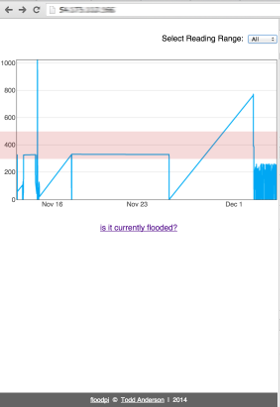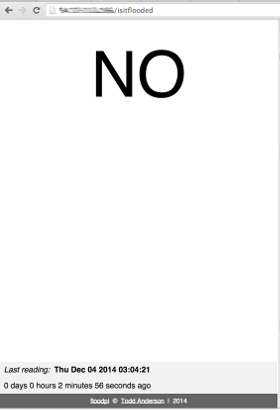RESTful administrative console for the flood-pi project.
Visit the flood-pi project for more information.
The flood-pi-admin is a NodeJS-based server that provides a RESTful API for POSTing and accessing flood level reading data posted by a flood-pi detector. It provides routing to show charting of aggregate data based on time range, as well as an immediate response to whether or not there is a flood detected:
flood-pi-admin requires NodeJS.
$ sudo apt-get update
$ curl -sL https://deb.nodesource.com/setup | sudo bash -
$ sudo apt-get install -y nodejs
Once NodeJS is set up on your system, pull the project from github and setup:
$ sudo apt-get install git
$ git clone https://github.com/bustardcelly/flood-pi-admin.git flood-pi-admin
$ cd flood-pi-admin
$ npm install
Running the server requires a config.json file to be present at the root of the project. The config.json.template file is available to be modifies and saved as config.json in the same directory with the necessary properties for dev and prod environments.
The dev configuration is probably sufficient for local development and will deploy the server on localhost at port 8001. The prod option should point to your production server host and port when deployed for production.
$ npm run build-client
$ npm run server
With the default options from config.json, open http://localhost:8001 and you should see a chart displaying the flood-level readings from a running flood-pi detector if set up to report to the localhost server.
It is recommended to install forever globally as there are npm script to start and stop the server as a daemon. Additionally, you should modify the "prod" entry of the config.json file to point to your production host and port that the flood-pi-admin server will be run.
$ npm install -g forever
$ mkdir log
$ npm run build-client-prod
$ npm run daemon-start
The following describes the API using cURL and assuming that the server is running on localhost at port 8001.
$ curl -X GET http://localhost:8001/isitflooded
Displays positive or negative result and last read statistics.
$ curl -X GET http://localhost:8001/
Displays all data repored by flood-pi detector.
$ curl -X GET http://localhost:8001/level
Shows results for last 24 hours.
$ curl -X GET http://localhost:8001/level?range=(day|week|year|all)
Shows results data on time range.
$ curl -X POST http://localhost:8001/level -H "Content-Type: application/json" -d '{"level":324}'
POSTs level reading value.
$ curl -X POST http://localhost:8001/configuration -H "Content-Type: application/json" -d '{"delay":15, "range": {"minimum": 300, "maximum": 500}}'
POSTs configuration object used in displaying data.
http://custardbelly.com/blog/blog-posts/2014/12/4/flood-pi/index.html

